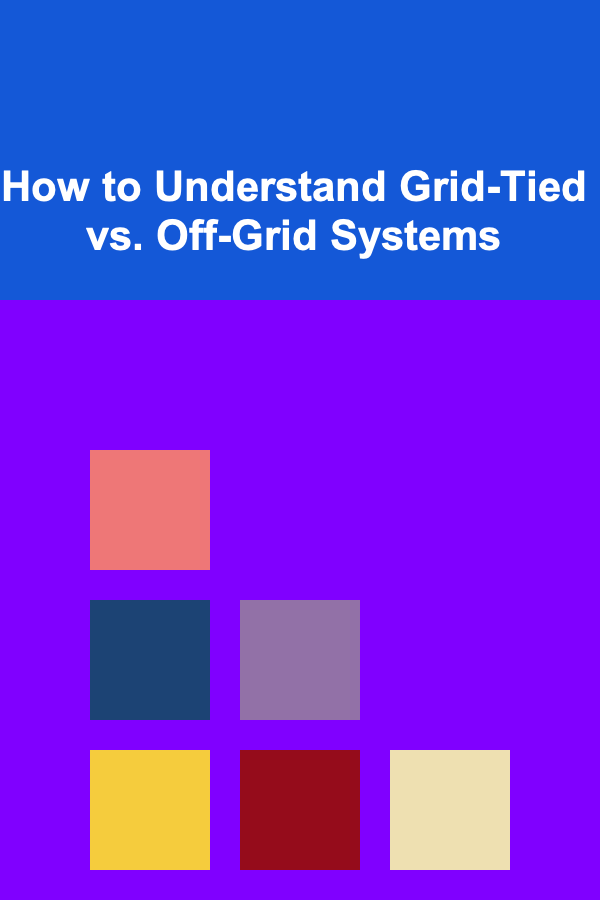
How to Understand Grid-Tied vs. Off-Grid Systems
ebook include PDF & Audio bundle (Micro Guide)
$12.99$5.99
Limited Time Offer! Order within the next:

In recent years, the debate surrounding energy systems has grown as individuals and businesses look for more sustainable ways to generate and consume electricity. Among the most popular options for homeowners and small businesses are grid-tied and off-grid energy systems. Each of these systems has its benefits and challenges, depending on the user's needs, the local environment, and their goals for energy independence.
This article explores the differences between grid-tied and off-grid systems, focusing on their components, advantages, disadvantages, and suitability for various scenarios. By the end, you'll have a clearer understanding of how these systems work, and how to choose the best option for your energy needs.
What Is a Grid-Tied System?
A grid-tied system, also known as a grid-connected system, is a type of energy system that is connected to the local electricity grid. In this setup, your energy generation system, often a solar panel array, produces electricity that is either consumed by your home or business or sent to the grid. The grid acts as a backup source of power when your system cannot meet the demand for electricity.
Components of a Grid-Tied System
- Solar Panels (or other renewable energy sources): The primary source of power generation in a grid-tied system is typically solar panels, although wind turbines and micro-hydro systems can also be used. These panels convert sunlight into electricity, which is then fed into your home or the grid.
- Inverter: The electricity generated by solar panels is direct current (DC), but most homes use alternating current (AC). An inverter converts the DC electricity into AC, making it suitable for household use.
- Utility Meter and Connection to the Grid: In a grid-tied system, you are still connected to the public electricity grid. This means you can send any excess power generated by your system back to the grid, and in some cases, you can be credited for it through a process known as net metering.
- Circuit Breaker and Distribution Panel: Just like in any conventional electrical system, your grid-tied system includes circuit breakers and a distribution panel that ensure the safe distribution of electricity throughout your property.
Advantages of a Grid-Tied System
- No Need for Battery Storage: One of the primary advantages of a grid-tied system is that you don't need to store excess power. If your solar panels generate more electricity than your home needs, the surplus is sent to the grid, and you receive credits on your utility bill (in areas with net metering policies). This reduces the need for costly battery storage systems, which are often a major expense in off-grid systems.
- Reliability and Backup Power: The grid acts as a backup, ensuring that you always have access to electricity, even when your solar panels aren't generating enough power (such as at night or on cloudy days). If your system isn't generating enough power to meet your demand, you can draw power from the grid.
- Cost Efficiency: Because you're not reliant on batteries or complex energy storage systems, grid-tied systems tend to have lower upfront costs than off-grid systems. You can also take advantage of net metering, which can result in financial savings by selling excess energy back to the grid.
- Environmentally Friendly: Solar power is a renewable energy source, and by using a grid-tied system, you reduce your carbon footprint. Additionally, because you're connected to the grid, you can still contribute to the overall reduction in greenhouse gas emissions even when you're not generating power.
Disadvantages of a Grid-Tied System
- Dependence on the Grid: While the grid provides backup power, it also means you're dependent on the local utility for energy. If the grid goes down due to a storm, natural disaster, or other reasons, your home will lose power unless you have an automatic transfer switch or a battery backup to provide energy in the event of a blackout.
- Limited Energy Independence: Even though you're generating your own electricity, a grid-tied system doesn't provide complete energy independence. You still rely on the utility for a portion of your power, especially when your renewable energy source isn't sufficient.
- Utility Fees and Regulations: In some regions, utilities charge additional fees for grid connection, which can add to your monthly costs. Furthermore, not all areas offer favorable net metering policies, which means you might not get full credit for the energy you send to the grid.
- Installation Restrictions: In some areas, there may be zoning regulations or restrictions that limit the installation of solar panels or wind turbines. This can make it harder to install a grid-tied system, especially in more densely populated areas.
What Is an Off-Grid System?
An off-grid system is an energy system that is not connected to the public electricity grid. Instead of relying on the grid for backup power, an off-grid system generates, stores, and uses all the electricity needed for the property. These systems are often used in remote locations, where grid access is not available or economically viable.
Components of an Off-Grid System
- Solar Panels (or other renewable energy sources): Similar to grid-tied systems, off-grid systems typically rely on solar panels, wind turbines, or hydroelectric systems for electricity generation. The key difference is that the energy generated is not sent to the grid but rather stored and used on-site.
- Battery Storage System: Since there is no grid to provide backup power, an off-grid system requires a battery bank to store the energy generated by the solar panels or other renewable sources. The stored energy is used during periods when the system is not generating electricity (e.g., at night or during cloudy days).
- Inverter: Like in a grid-tied system, an inverter is necessary to convert the DC electricity produced by the renewable energy sources into usable AC power for household use.
- Charge Controller: This component regulates the flow of electricity into the batteries, ensuring that they do not become overcharged or discharged too much, which can shorten their lifespan.
- Backup Generator (Optional): In some off-grid systems, particularly in areas with extended periods of cloud cover or minimal wind, a backup generator may be used to provide additional power when renewable sources cannot meet the energy demand.
Advantages of an Off-Grid System
- Energy Independence: Off-grid systems allow homeowners and businesses to achieve complete energy independence. Without reliance on the grid, you generate and consume your own electricity, insulating yourself from rising energy costs or power outages caused by grid failures.
- Flexibility and Freedom: Off-grid systems are ideal for remote locations, such as rural homes, cabins, or farms, where grid access is not available. They provide the flexibility to live anywhere without being tethered to the power grid.
- No Monthly Utility Bills: Since you're not connected to the grid, you won't have to pay monthly utility bills. Once the system is paid for, your electricity costs are generally limited to maintenance and replacement of components (e.g., batteries).
- Environmentally Friendly: Like grid-tied systems, off-grid systems using renewable energy sources help reduce your carbon footprint. You're not relying on fossil fuels to generate electricity, which makes off-grid systems an excellent choice for environmentally conscious individuals.
Disadvantages of an Off-Grid System
- High Initial Costs: Off-grid systems often require a significant upfront investment in renewable energy generation equipment, battery storage, and backup generators. While the operating costs are low, the initial setup can be expensive.
- Energy Storage and Battery Maintenance: The battery storage system is a critical component of an off-grid system, and batteries can be costly to replace over time. Additionally, batteries require maintenance, including monitoring their charge levels and ensuring they are functioning properly.
- Limited Power Availability: In an off-grid system, your ability to generate and store electricity is limited by the size of your solar panels, wind turbines, and battery bank. On cloudy or windless days, your energy production may not meet your demand, and you may need to rely on your backup generator.
- Complexity in System Design: Designing an off-grid system that meets all your energy needs can be complex. You need to carefully calculate your energy consumption, select appropriate-sized components, and plan for future energy demands. This complexity often requires professional consultation to ensure the system is correctly designed and sized.
- Environmental Constraints: Off-grid systems rely heavily on local weather conditions. For example, solar panels are not as effective in areas with long winters or frequent cloudy days. Similarly, wind turbines may not perform well in regions with little wind.
Grid-Tied vs. Off-Grid: Which One Is Right for You?
Choosing between a grid-tied and an off-grid system depends on several factors, including your location, budget, energy needs, and long-term goals for sustainability and energy independence.
Considerations for Grid-Tied Systems
- Location: If you're in an area with reliable grid access and favorable net metering policies, a grid-tied system might be your best option.
- Budget: If you're looking for a more affordable and less complicated system to start with, grid-tied systems are generally more cost-effective.
- Energy Independence: If you want to be partially or fully independent of the grid but are not yet ready to fully disconnect, a hybrid approach with battery backup can offer some independence while still benefiting from grid access.
Considerations for Off-Grid Systems
- Location: If you live in a remote location with no access to the grid, an off-grid system might be your only viable option.
- Energy Needs: Off-grid systems are ideal for people who are conscious of their energy consumption and are willing to invest in energy storage solutions.
- Long-Term Goals: If your goal is full energy independence and you're willing to invest in a reliable backup power source, an off-grid system is a great choice.
Conclusion
Both grid-tied and off-grid systems have their strengths and weaknesses. Grid-tied systems offer a simpler, more cost-effective way to reduce energy costs and rely on renewable energy, while off-grid systems provide greater independence but come with higher upfront costs and maintenance responsibilities. The choice between these systems ultimately depends on your specific circumstances, including location, budget, and long-term goals for energy independence and sustainability.
By understanding the core differences between grid-tied and off-grid systems, you can make a more informed decision about which system is best suited to your needs. Whether you're looking to save on energy bills, reduce your carbon footprint, or achieve total energy independence, both systems offer valuable solutions for the modern energy landscape.

How to Maximize Space in a Small Apartment
Read More
How to Store Utensils Safely for Child-Friendly Kitchens
Read More
How to Use a Binder to Organize Craft Patterns
Read More
How to Use Lighting to Highlight Artwork in Your Home
Read More
How to Grasp the Concepts of Transcription and Translation
Read More
How to Repair and Restore Antique License Plates
Read MoreOther Products

How to Maximize Space in a Small Apartment
Read More
How to Store Utensils Safely for Child-Friendly Kitchens
Read More
How to Use a Binder to Organize Craft Patterns
Read More
How to Use Lighting to Highlight Artwork in Your Home
Read More
How to Grasp the Concepts of Transcription and Translation
Read More